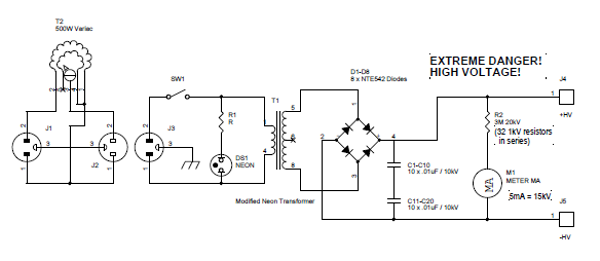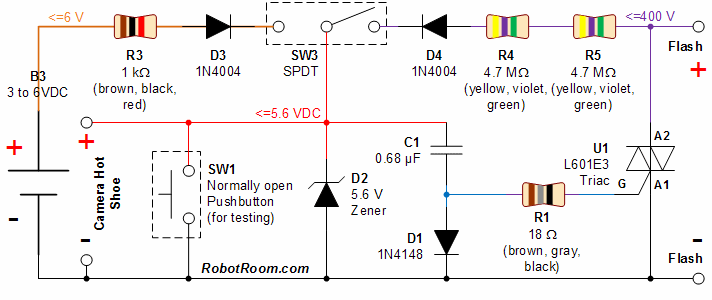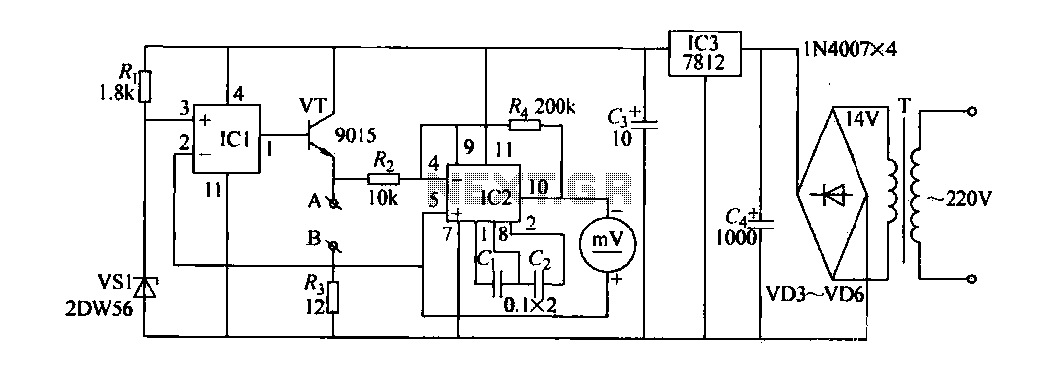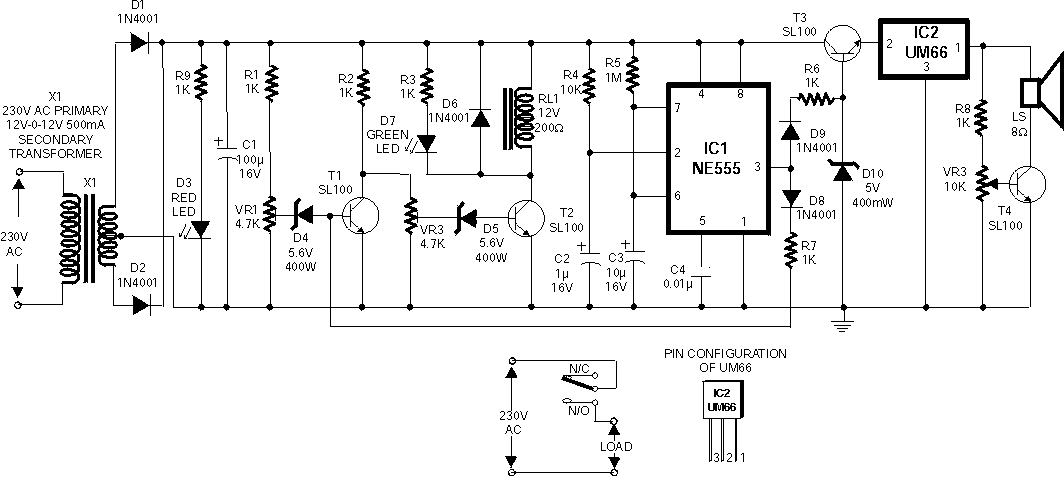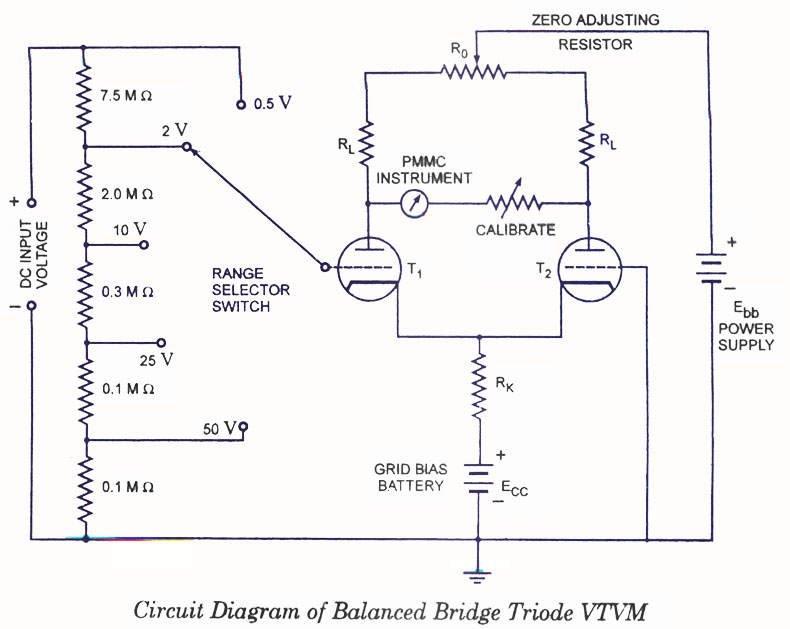
universal high resistance voltmeter
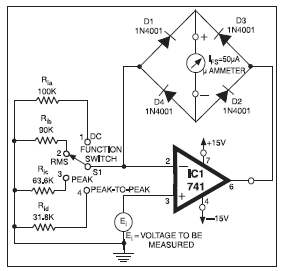
The full-scale deflection of the universal high-input-resistance voltmeter circuit depends on the position of the function switch. The term IFS in the equations refers to the meter's full-scale deflection current rating in amperes. It is important to note that neither the meter resistance nor the diode voltage drops affect the meter current. A high-input-resistance operational amplifier, a bridge rectifier, a microammeter, and a few other discrete components are required to realize this versatile circuit. This circuit can be used for the measurement of DC, AC RMS, AC peak, or AC peak-to-peak voltage by simply changing the value of the resistor connected between the inverting input terminal of the op-amp and ground. The voltage to be measured is connected to the non-inverting input of the op-amp.
The universal high-input-resistance voltmeter circuit is designed to offer flexibility in measuring various voltage types, including direct current (DC) and alternating current (AC) in different forms such as root mean square (RMS), peak, and peak-to-peak values. The operational amplifier (op-amp) serves as the core component, providing high input impedance, which minimizes the loading effect on the circuit being measured.
The function switch in the circuit allows users to select the desired measurement type, effectively configuring the circuit for optimal performance depending on the application. The full-scale deflection current rating (IFS) is crucial for ensuring that the microammeter displays accurate readings, and it is determined by the specific resistor value used in conjunction with the op-amp.
The bridge rectifier converts AC signals into a DC format, facilitating easier measurement with the microammeter. By adjusting the resistor connected to the inverting input of the op-amp, the circuit can be calibrated to accommodate different voltage ranges, enhancing its versatility.
In practical applications, the non-inverting input of the op-amp is connected to the voltage source under test, while the inverting input is linked to ground through the adjustable resistor. This configuration allows the op-amp to amplify the input signal, providing a clear and precise reading on the microammeter, which is essential for accurate voltage measurements across various scenarios.
Overall, this circuit exemplifies an efficient design for voltage measurement, combining essential components to achieve a wide range of functionalities while maintaining high accuracy and reliability.The full-scale deflection of the universalhigh-input-resistance voltmetercircuit shown in the figuredepends on the function switch positionas follows: The term IFS in the aboveequations refers to meter`s fullscaledeflection current rating inamperes. It must be noted that neithermeter resistance nor diode voltagedrops affects meter current. A high-i nput-resistance op-amp, abridge rectifier, a microammeter, and afew other discrete components are all thatare required to realise this versatile circuit. This circuit can be used for measurementof DC, AC RMS, AC peak, orAC peak-to-peak voltage by simply changing the value of the resistor connected betweenthe inverting input terminal of theop-amp and ground.
The voltage to bemeasured is connected to non-inverting inputof the op-amp. 🔗 External reference
The universal high-input-resistance voltmeter circuit is designed to offer flexibility in measuring various voltage types, including direct current (DC) and alternating current (AC) in different forms such as root mean square (RMS), peak, and peak-to-peak values. The operational amplifier (op-amp) serves as the core component, providing high input impedance, which minimizes the loading effect on the circuit being measured.
The function switch in the circuit allows users to select the desired measurement type, effectively configuring the circuit for optimal performance depending on the application. The full-scale deflection current rating (IFS) is crucial for ensuring that the microammeter displays accurate readings, and it is determined by the specific resistor value used in conjunction with the op-amp.
The bridge rectifier converts AC signals into a DC format, facilitating easier measurement with the microammeter. By adjusting the resistor connected to the inverting input of the op-amp, the circuit can be calibrated to accommodate different voltage ranges, enhancing its versatility.
In practical applications, the non-inverting input of the op-amp is connected to the voltage source under test, while the inverting input is linked to ground through the adjustable resistor. This configuration allows the op-amp to amplify the input signal, providing a clear and precise reading on the microammeter, which is essential for accurate voltage measurements across various scenarios.
Overall, this circuit exemplifies an efficient design for voltage measurement, combining essential components to achieve a wide range of functionalities while maintaining high accuracy and reliability.The full-scale deflection of the universalhigh-input-resistance voltmetercircuit shown in the figuredepends on the function switch positionas follows: The term IFS in the aboveequations refers to meter`s fullscaledeflection current rating inamperes. It must be noted that neithermeter resistance nor diode voltagedrops affects meter current. A high-i nput-resistance op-amp, abridge rectifier, a microammeter, and afew other discrete components are all thatare required to realise this versatile circuit. This circuit can be used for measurementof DC, AC RMS, AC peak, orAC peak-to-peak voltage by simply changing the value of the resistor connected betweenthe inverting input terminal of theop-amp and ground.
The voltage to bemeasured is connected to non-inverting inputof the op-amp. 🔗 External reference
